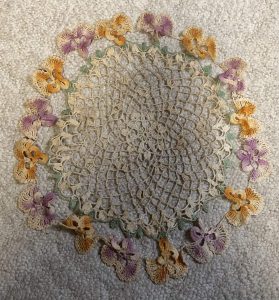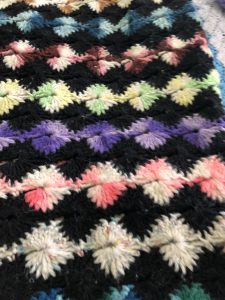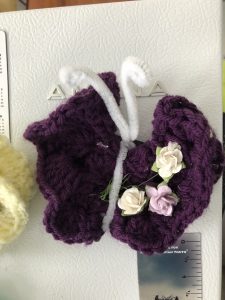Madison Smith
Newswriting II
May 2021

Crocheting during a pandemic
During this pandemic and lockdowns people have become bored with their everyday routines and are turning to a 17th century cure: Crocheting.
Most people know more about knitting than crocheting. The differences between knitting and crocheting are, knitting use two while those who crochet use just one hook.
In crocheting there are multiple different patterns you can use. You have the granny square, which has multiple variations. And guess what? They do not even have to do a square. The granny square is small little pieces of yarn that get crocheted and then sewed together to make a blanket. As you can see in the two photos how different both granny squares are. Once you got the simple pattern down, you can then move on to the more intercut patterns like the granny square that Edith Arnold made that she did not turn into a blanket.

When beginning your crocheting journey, you should always start off with a simple three-stitch pattern which is where you take the loop that you have after your knot and then you first start with your chain which is where you just keep taking your hook and putting a piece of yarn onto it.
Guinnevere Almquist, 20, who is from Willington, Connecticut, recently started to crochet. “My grandmother tried to teach me, but I couldn’t get it. Years later one of my best friends effectively taught me how to crochet.” Not everyone who learns how figures it out and it can get frustrating at times, but it can be achieved if you just keep practicing.
Almquist also said that she likes to make hats and has her own process of starting a new project. “I feel bored, then I turn on the TV and crochet and feel less bored.”
During a pandemic people’s emotions start to run high due to the unknowns about the virus, especially in the early days of the pandemic. This is clearly shown in an elementary school in Rockford, Illinois. Ashley Robinson-Walker, who is a trauma therapist and founder of the crocheting club, says, “The crocheting club helps relax students from the stress and anxiety from everyday life and with the added stress of the pandemic.” With everything that is going on being stressed out is not a healthy way to live. Through this crocheting club Robinson-Walker says, “It helps the girls who are having a hard time dealing with the stress and it helps them relax and talk about what is mentally hurting them.”

Crocheting is for everyone all you need is a hook, yarn, scissors, and a crocheting book or teacher to make whatever comes to mind. Julia Clark from the Willington Knitting Club says, “You can make anything you want out of yarn, you could make a sweater, scarf, or maybe some mittens, but it is all about patience because it takes time and some mistakes to be able to make a blanket or a scarf.” Just like how you make mistakes in life you can make mistakes in crocheting and miss a whole stich and start your row all over again. Clark says, “The fun in crocheting is that you can be at any skill level and make a wonderful project and if the power ever goes out you still have something to do till the power comes back on.”

Knitting Criations owner says, “During the pandemic they made roughly double of the amount that they made before the pandemic.” They are currently making about 54 thousand dollars in total sales per year of yarn, crocheting and knitting accessories, books, and patterns to name a few things they sell. They are known for selling high quality yarns from local and non-local vendors. They are also open to the public and have classes and workshops to help you learn how to crochet or knit and those cost ten dollars per two-hour sessions. The instructor of the class is there to make sure that the pattern matches the project. Knitting Criations is open Tuesday-Wednesday 10 a.m.-8 p.m., Thursday 10 a.m. — 6 p.m., Friday 10 a.m. — 5 p.m., and on Saturday 10 a.m. — 4 p.m. in Somers, Connecticut.
Crocheting has been a pastime for so many people over the generations. This was the way most people had blankets to keep warm in the winter for an affordable price and to make ornaments for the Christmas tree and other decorations. It was also used as a tool to help the children learn how to make something that they would be proud of the result but also learning how to be careful not to tangle the yarn and to be able to make a mistake and figure out how to fix it and to ask for help when they did need help.

Karen Smith’s uncle. / Photo by Madison Smith
Crocheting can help you relax because you can just sit down and turn on some music and just go through the motions of putting each stich together and to change up the color every once and a while and you do not have to worry about the pressures of making sure that what you are making is someone else’s definition of perfect. You get to say that you made something instead of buying a similar crocheted blanket for $10 to $51 on amazon when you can make it for like $10 or less yourself. You do not have to crochet by yourself get your friends together, socially distanced, and sit and talk while having some background music and in no time, you will have a scarf made within about two to three hours.
Crocheting can teach you some lessons that you did not even realize, for example, you could learn what your coping mechanism is for what you might be going through now. It is better than drinking your problems away or even smoking. Crocheting is a way for you to slowly get rid of some emotional problems in your life while keeping you healthy and it is a great way to make friends if you join a crocheting or knitting group. You do not have to keep the items that you make you can give them to friends and family as a present or you can donate them to hospitals, senior housing, homeless shelters, animal shelters, animal hospitals, NICU, basically anywhere that takes donations and gives them to people who need it. Once you get the hang of it you can also teach any of your friends who want to learn how to crochet so you guys can hangout and crochet together.
If you do not like crocheting after you have tried it you can always stop and either come back at a later point or you can donate the yarn and hook to a thrift store that sells craft items so that someone else can start their own project even if they do not have all the money to get the items.

Karen Smith is the authors grandmother, and all the pictures are of her creations and her families’ creations that have been passed down through the generations.
Leave a Reply
You must be logged in to post a comment.